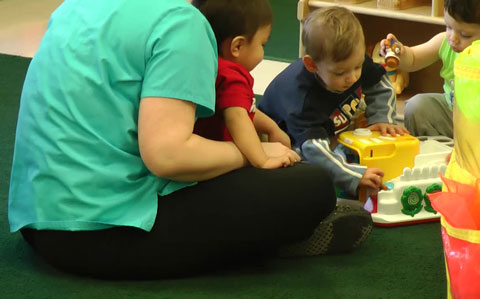About this video
This video takes place in an infant/toddler room of a university laboratory child care center and preschool during free play time. Jayden (20 months) and the teacher, Cassie, are sitting on the floor engaged with an activity box. Two more children, Spencer (20 months) and Mason (21 months), join them as they explore how the toy works. Cassie demonstrates activating the toy, and the children follow her lead. This interaction shows how the teacher appropriately engages the children by asking Spencer to participate and redirecting Mason when he takes the bear.
Video
Transcript
Jayden and the teacher, Cassie, are sitting on the floor next to a small activity box. The teacher pushes a button to make a bear jump, to which Jayden reacts with a hearty giggle.
Teacher: Ooh. Ooh.
Spencer joins the group and sits on the teacher’s lap.
Cassie: Ready? Boing!
Jayden giggles.
Cassie: Can you push the button? You push it. Ready? Can you push it, Spencer?
Spencer pushes the button. Jayden giggles.
Cassie:? Boing! (Jayden giggles.)
Jayden twice says his name; his attempt sounds like “the end.”
Cassie: Ready? Boing! (pointing to the other side of the toy) Actually, what’s this thing up here? Does this go here? Can you put him … her in there? Put her right here. Now push this button. Can you push right there?
Another teacher is having an off-camera conversation with a child.
Mason: Mine. (He pulls a bear away from the toy just as Spencer is about to make it jump.)
Cassie: Oh. Hold on. They are playing with it too. You can play on that side, Mason. Ready? Boing!
Illinois Early Learning Guidelines for Children Birth to Age Three and strategies that caregivers used
Self-Regulation: Foundation of Development
Behavior Regulation
Children demonstrate the emerging ability to manage and adjust behaviors in accordance with social and cultural contexts.
- Strategies for interaction (16-24 months):
- Provide the child with clear limits and provide reminders of them through the day
- Model thoughtful and respectful behavior when interacting with the child
- Action: After Mason tried to take a bear, the teacher told him that the others were playing on one side and that he could play on the other side.
Developmental Domain 1: Social & Emotional Development
Relationship with Adults
Children demonstrate the desire and develop the ability to engage, interact, and build relationships with familiar adults.
- Strategies for interaction (16-24 months): Set appropriate and consistent limits; ensure to take realistic expectations into account.
- Action: The teacher let Mason know that he could play with the toy but would need to stay on one side, most likely because it was crowded around the small toy.
Developmental Domain 3: Language Development, Communication, & Literacy
Receptive Communication
Children demonstrate the ability to comprehend both verbal and nonverbal communication.
- Strategies for interaction (16-24 months): Use gestures while asking the child to complete actions
- Action: The teacher pointed to the lever that made the small bear jump and encouraged the children to try it themselves.
Developmental Domain 4: Cognitive Development
Logic & Reasoning
Children demonstrate the ability to use knowledge, previous experiences, and trial and error to make sense of and impact their world.
- Strategies for interaction (16-24 months): Provide the child with experiences that demonstrate cause and effect
- Action: The teacher demonstrated how the toy worked and encouraged the children to try it themselves.
Approaches to Learning
Persistence, Effort, & Attentiveness
Children demonstrate the ability to remain engaged in experiences and develop a sense of purpose and follow-through.
- Strategies for interaction (16-24 months): Provide the child with different manipulatives that he or she can explore independently
- Action: The teacher helped to keep the children engaged by encouraging them to push the lever and reacting positively to their efforts.


